
San Domenico is a Gothic-style, Roman Catholic church located on via Berrettini in Cortona, region of Tuscany, Italy.

San Domenico is a Gothic-style, Roman Catholic church located on via Berrettini in Cortona, region of Tuscany, Italy.
A convent and a small church were built here beginning in 1230, but after new land adjacent to these structures was acquired, the new church we see today was completed in 1438. The complex was built outside the walls of the time, near where once stood the Porta Peccioverardi. A major refurbishment occurred in the 1590s.
The Dominican convent was suppressed by the Grand-Duke's edict in 1786, and the convent was occupied by the Servites until their suppression in 1800. The church fell into disrepair, and most of the convent was destroyed to build new roads in 1817-1819.
The unfinished grey stone brick facade with a peaked portal and a single small oculus leads into a well organized interior nave with elaborate side altars. In the lunette over the doorway there is a fresco by Fra Angelico, depicting the Madonna and child with Saints Dominic and Peter Martyr. Fra Angelico once lived in the monastery.
The main altarpiece is a triptych by Lorenzo di Niccolò of Florence, depicting the Coronation of the Virgin, the Annunciation, the Crucifixion, and other scenes. Epigraphs and signatures on the work document the painter and that it was donated in 1440 by Cosimo I de' Medici.
Some of the lateral altarpieces have been moved to the Diocesan Museum, and occasionally re-placed at their original sites. On the left is a Madonna with Angels and Franciscan Saints by Luca Signorelli. A triptych by Sassetta and an Assumption by Bartolomeo della Gatta can now be admired in the Diocesan Museum. [1]

Fra Angelico, O.P. was a Dominican friar and Italian Renaissance painter of the Early Renaissance, described by Giorgio Vasari in his Lives of the Artists as having "a rare and perfect talent". He earned his reputation primarily for the series of frescoes he made for his own friary, San Marco, in Florence, then worked in Rome and other cities. All his known work is of religious subjects.

Luca Signorelli was an Italian Renaissance painter from Cortona, in Tuscany, who was noted in particular for his ability as a draftsman and his use of foreshortening. His massive frescos of the Last Judgment (1499–1503) in Orvieto Cathedral are considered his masterpiece.

Benozzo Gozzoli was an Italian Renaissance painter from Florence. A pupil of Fra Angelico, Gozzoli is best known for a series of murals in the Magi Chapel of the Palazzo Medici-Riccardi, depicting festive, vibrant processions with fine attention to detail and a pronounced International Gothic influence. The chapel's fresco cycle reveals a new Renaissance interest in nature with its realistic depiction of landscapes and vivid human portraits. Gozzoli is considered one of the most prolific fresco painters of his generation. While he was mainly active in Tuscany, he also worked in Umbria and Rome.
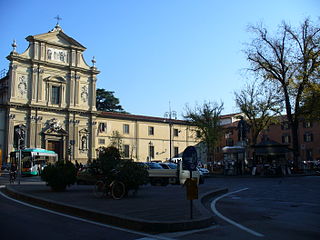
Museo Nazionale di San Marco is an art museum housed in the monumental section of the medieval Dominican convent of San Marco dedicated to St Mark, situated on the present-day Piazza San Marco, in Florence, a region of Tuscany, Italy.

Lorenzo di Niccolò or Lorenzo di Niccolò di Martino was an Italian painter who was active in Florence from 1391 to 1412. This early Renaissance artist worked in the Trecento style, and his work maintains influences of the Gothic style, marking a transitional period between the Gothic sensibilities of the Middle Ages while simultaneously beginning to draw on the Classical. Lorenzo's works were usually religious scenes in tempera with gold backgrounds.
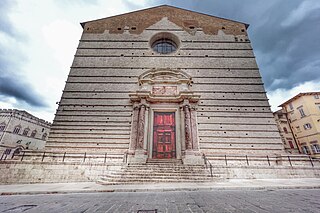
Perugia Cathedral, officially the Metropolitan Cathedral of St. Lawrence, is a Roman Catholic cathedral in Perugia, Umbria, central Italy, dedicated to Saint Lawrence. Formerly the seat of the bishops and archbishops of Perugia, it has been since 1986 the archiepiscopal seat of the Archdiocese of Perugia-Città della Pieve.
The decade of the 1430s in art involved some significant events.

San Bernardino is a church in Verona, northern Italy. The church, in Gothic style, was built from 1451 to 1466.

The Prado Annunciation is an altarpiece painted by the Italian Renaissance painter Giovanni da Fiesole, known as Fra Angelico, in the 1420s. It is one of his best-known works. Originally destined for the convent of the observant Dominicans of Fiesole, the painting is currently in the collection of the Museo del Prado in Madrid. It is one of three altarpieces by Fra Angelico representing the Annunciation; the other two being the Cortona Annunciation and the Annunciation of San Giovanni Valdarno. The sequence in which the three works were painted is not certain, but the general art historical consensus places the Prado version first.

The Annunciation of Cortona is a panel-painting altarpiece or retable by the Italian Renaissance painter Fra Angelico: once housed in the Church of Gesù of Cortona, it is now held at the Museo Diocesano in Cortona.

The Diocesan Museum in Cortona is an art museum in Cortona, Tuscany, Italy. Located on the former site of the local Church of Gesù, it houses works of art by artists such as Fra Angelico, Pietro Lorenzetti, Bartolomeo della Gatta, Luca Signorelli and Sassetta. The oldest item in the museum is a marble Roman sarcophagus, depicting depicts the battle of Dionysus.

The Cortona Triptych is a Catholic Church depiction of the Madonna and Child with saints, painted by Fra Angelico. It is now kept at the Diocesan Museum in Cortona, Italy. The painting dates from 1436–1437.
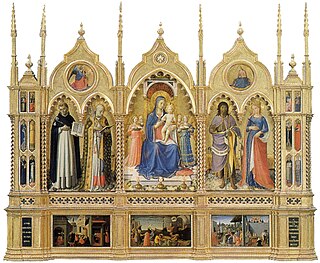
The Perugia Altarpiece is a painting by the Italian early Renaissance painter Fra Angelico, housed in the Galleria Nazionale dell'Umbria of Perugia, Italy.

The Fiesole Altarpiece is a painting by the Italian early Renaissance master Fra Angelico, executed around 1424–1425. It is housed in the Convent of San Domenico, Fiesole, central Italy. The background was repainted by Lorenzo di Credi in 1501.

The St. Peter of Verona Triptych is a tempera-on-panel painting by the Italian early Renaissance master Fra Angelico, executed around 1428–1429. It is housed in the National Museum of San Marco in Florence, Italy.
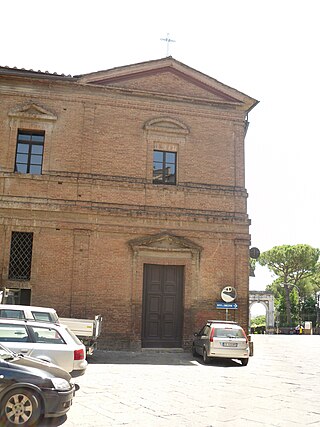
The Church of the Santuccio or Chiesa del Santuccio, is a small, Renaissance-style, Roman Catholic church located on Via Roma 69 in Siena, Italy. The church was once was part of the adjacent monastery of Santa Maria degli Angeli, occupied since 1362 by Augustinian nuns. The frescoed church is not part of the Polo Museale della Toscana, an association of museums of the Tuscan region.

Zanobi di Benedetto di Caroccio degli Strozzi, normally referred to more simply as Zanobi Strozzi, was an Italian Renaissance painter and manuscript illuminator active in Florence and nearby Fiesole. He was closely associated with Fra Angelico, probably as his pupil, as told by Vasari. He is the same painter as the Master of the Buckingham Palace Madonna. Most of his surviving works are manuscript illuminations but a number of panel paintings have also been attributed to him, including seven altarpieces and six panels with the Virgin and Child, along with some designs for metalwork.
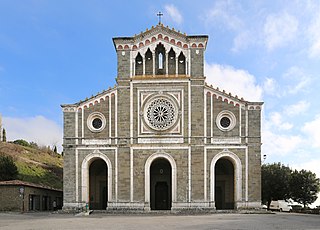
Basilica of Santa Margherita is a neo-Gothic style, Roman Catholic church, located just outside the Tuscan town of Cortona, Italy, at the intersection of Via delle Santucce and Via Sant Margherita, on a hill just below the Fortezza Medicea, and dedicated to a native saint of the town, Margaret of Cortona.

Andrea di Giusto, rarely also known as Andrea Manzini or Andrea di Giusto Manzini was a Florentine painter of the late Gothic to early Renaissance style in Florence and its surrounding countryside. Andrea was heavily influenced by masters Lorenzo Monaco, Bicci di Lorenzo, Masaccio, and Fra Angelico, and tended to mix and match the motifs and techniques of these artists in his own work. Andrea was an eclectic painter and is considered a minor master of Florentine early Renaissance art. Andrea trained under Bicci di Lorenzo as a Garzone. He painted his most significant works, three altarpieces, in the Florentine contado, or countryside; these altarpieces were created for Sant’Andrea a Ripalta in Figline, Santa Margarita in Cortona, and the Badia degli Olivetani di San Bartolomeo alle Sacce near Prato. Aside from his major altarpieces, Andrea painted several Frescoes over the course of his career. He, along with other minor masters, are also known to have provided several different types of art, including triptychs and frescoes, for Romanesque pievi, or rural churches with baptistries. Moreover, he was well known for several types of smaller craft objects, such as small tabernacles. He is said to have worked between 1420 and 1424 under Bicci di Lorenzo on paintings for Santa Maria Nuova. He is said to have worked with Masaccio in painting the Life of San Giuliano for the Polyptych of Pisa, including the painting of the Madonna and Child, in 1426. He also appears to have collaborated in 1445 with Paolo Uccello in the Capella dell'Assunta in the Prato Cathedral. In 1428, he is listed as a member of the Arte dei Medici e Speziali guild in Florence as "Andrea di Giusto di Giovanni Bugli". His son, Giusto d'Andrea, was also a painter and worked with Neri di Bicci and Benozzo Gozzoli. Andrea died in Florence in 1450.
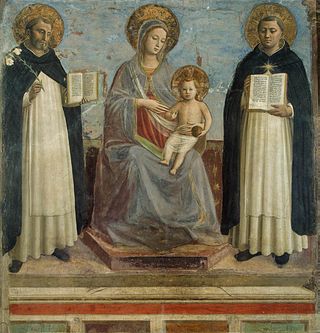
Madonna and Child is a c.1435 fresco fragment by the Italian Renaissance master Fra Angelico in the sacra conversazione style. It was originally painted in the dormitory of the Convent of San Domenico, Fiesole. It was removed from the wall after the convent's suppression during the Napoleonic occupation of Italy and is now in the Hermitage Museum in St Petersburg.